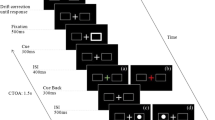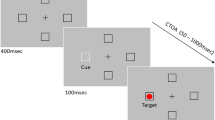Abstract
Inhibition of return (IOR) refers to an increase in reaction times to targets that appeared at a previously cued location relative to an uncued location, often investigated using a spatial cueing paradigm. Despite numerous studies that have examined many aspects of IOR, the neurophysiological mechanisms underlying IOR are still in dispute. The objective of the current research is to investigate the plausible mechanisms by manipulating the cue and target types between central and peripheral stimuli in a traditional cue–target paradigm with saccadic responses to targets. In peripheral-cueing conditions, we observed inhibitory cueing effects across all cue–target onset asynchronies (CTOAs) with peripheral targets, but IOR was smaller and arose later with central targets. No inhibition was observed in central-cueing conditions at any CTOAs. Empirical data were simulated using a two-dimensional dynamic neural field model. Our results and simulations support previous work demonstrating that, at short CTOAs, behavioral inhibition is only observed with repeated stimulation—an effect of sensory adaptation. With longer CTOAs, IOR is observed regardless of target type when peripheral cueing is used. Our findings suggest that behaviorally exhibited inhibitory cueing effects can be attributed to multiple mechanisms, including both attenuation of visual stimulation and local inhibition in the superior colliculus.



Similar content being viewed by others
References
Amari S (1977) Dynamics of pattern formation in lateral-inhibition type neural fields. Biol Cybern 27:77–87. https://doi.org/10.1007/BF00337259
Bao Y, Wang Z, Liang W, Wang Y, Pöppel E, Li H (2013) Inhibition of return at different eccentricities in the visual field share the same temporal window. Neurosci Lett 534:7–11. https://doi.org/10.1016/j.neulet.2012.11.046
Bell AH, Munoz DP (2008) Activity in the superior colliculus reflects dynamic interactions between voluntary and involuntary influences on orienting behaviour. Eur J Neurosci 28:1654–1660. https://doi.org/10.1111/j.1460-9568.2008.06393.x
Chica AB, Martín-Arévalo E, Botta F, Lupiáñez J (2014) The spatial orienting paradigm: how to design and interpret spatial attention experiments. Neurosci Biobehav Rev 40:35–51. https://doi.org/10.1016/j.neubiorev.2014.01.002
Colby CL, Goldberg ME (1999) Space and attention in parietal cortex. Annu Rev Neurosci 22:319–349. https://doi.org/10.1146/annurev.neuro.22.1.319
Dorris MC, Klein RM, Everling S, Munoz DP (2002) Contribution of the primate superior colliculus to inhibition of return. J Cognit Neurosci 14:1256–1263. https://doi.org/10.1162/089892902760807249
Fecteau JH, Munoz DP (2005) Correlates of capture of attention and inhibition of return across stages of visual processing. J Cognit Neurosci 17:1714–1727. https://doi.org/10.1162/089892905774589235
Fecteau JH, Munoz DP (2006) Salience, relevance, and firing: a priority map for target selection. Trends Cognit Sci 10:382–390. https://doi.org/10.1016/j.tics.2006.06.011
Gabay S, Henik A (2010) Temporal expectancy modulates inhibition of return in a discrimination task. Psychon Bull Rev 17:47–51. https://doi.org/10.3758/PBR.17.1.47
Harris CM, Wolpert DM (2006) The main sequence of saccades optimizes speed-accuracy trade-off. Biol Cybern 95:21–29. https://doi.org/10.1007/s00422-006-0064-x
Hilchey MD, Klein RM, Ivanoff J (2012) Perceptual and motor inhibition of return: components or flavors? Atten Percept Psychophys 74:1416–1429. https://doi.org/10.3758/s13414-012-0332-x
Hilchey MD, Klein RM, Satel J (2014) Returning to “inhibition of return” by dissociating long-term oculomotor IOR from short-term sensory adaptation and other nonoculomotor “inhibitory” cueing effects. J Exp Psychol Hum Percept Perform 40:1603–1616. https://doi.org/10.1037/a0036859
Hunt AR, Kingstone A (2003) Inhibition of return: dissociating attentional and oculomotor components. J Exp Psychol Hum Percept Perform 29:1068–1074. https://doi.org/10.1037/0096-1523.29.5.1068
Isoda M, Hikosaka O (2008) A neural correlate of motivational conflict in the superior colliculus of the macaque. J Neurophysiol 100:1332–1342. https://doi.org/10.1152/jn.90275.2008
Ivanoff J, Klein RM (2001) The presence of a non-responding effector increases inhibition of return. Psychon Bull Rev 8:307–314. https://doi.org/10.3758/BF03196166
Jordan H, Tipper SP (1998) Object-based inhibition of return in static displays. Psychon Bull Rev 5:504–509. https://doi.org/10.3758/BF03208829
Klein RM (1988) Inhibitory tagging system facilitates visual search. Nature 334:430–431. https://doi.org/10.1038/334430a0
Luo C, Lupiáñez J, Funes MJ, Fu X (2013) Reduction of the spatial Stroop effect by peripheral cueing as a function of the presence/absence of placeholders. PLoS One 8(7):e69456. https://doi.org/10.1371/journal.pone.0069456
Martín-Arévalo E, Chica AB, Lupiáñez J (2013) Task dependent modulation of exogenous attention: effects of target duration and intervening events. Attent Percept Psychophys 75:1148–1160. https://doi.org/10.3758/s13414-013-0481-6
Müller HJ, Rabbitt PMA (1989) Reflexive and voluntary orienting of visual attention: time course of activation and resistance to interruption. J Exp Psychol Hum Percept Perform 15:315–330. https://doi.org/10.1037/0096-1523.15.2.315
Posner MI, Cohen Y (1984) Components of visual orienting. In: Bouma H, Bouwhuis DG (eds) Attention and performance X. Lawrence Erlbaum, Hillsdale, pp 531–556
Posner MI, Rafal RD, Choate LS, Vaughan J (1985) Inhibition of return: neural basis and function. Cognit Neuropsychol 2:211–228. https://doi.org/10.1080/02643298508252866
Ristic J, Kingstone A (2012) A new form of human spatial attention: automated symbolic orienting. Vis Cognit 20:244–264. https://doi.org/10.1080/13506285.2012.658101
Samuel AG, Kat D (2003) Inhibition of return: a graphical meta-analysis of its time course and an empirical test of its temporal and spatial properties. Psychon Bull Rev 10:897–906. https://doi.org/10.3758/BF03196550
Satel J, Wang Z (2012) Investigating a two causes theory of inhibition of return. Exp Brain Res 223:469–478. https://doi.org/10.1007/s00221-012-3274-6
Satel J, Wang Z, Trappenberg TP, Klein RM (2011) Modeling inhibition of return as short-term depression of early sensory input to the superior colliculus. Vis Res 51:987–996. https://doi.org/10.1016/j.visres.2011.02.013
Satel J, Wang Z, Hilchey MD, Klein RM (2012) Examining the dissociation of retinotopic and spatiotopic inhibition of return with event-related potentials. Neurosci Lett 524:40–44. https://doi.org/10.1016/j.neulet.2012.07.003
Satel J, Story R, Hilchey MD, Wang Z, Klein RM (2013) Using a dynamic neural field model to explore a direct collicular inhibition account of inhibition of return. In: Proceedings of the 6th international symposium on attention in cognitive systems, vol 1, pp 1–12. http://arxiv.org/abs/1307.5684
Satel J, Fard FS, Wang Z, Trappenberg TP (2014) Simulating oculomotor inhibition of return with a two-dimensional dynamic neural field model of the superior colliculus. Austr J Intell Inf Process Syst 14:27–32
Smith TJ, Henderson JM (2011) Does oculomotor inhibition of return influence fixation probability during scene search? Atten Percept Psychophys 73:2384–2398. https://doi.org/10.3758/s13414-011-0191-x
Taylor TL, Donnelly MPW (2002) Inhibition of return for target discriminations: the effect of repeating discriminated and irrelevant stimulus dimensions. Percept Psychophys 64:292–317. https://doi.org/10.3758/BF03195793
Taylor TL, Klein RM (2000) Visual and motor effects in inhibition of return. J Exp Psychol Hum Percept Perform 26:1639–1656. https://doi.org/10.1037/0096-1523.26.5.1639
Tipper SP, Weaver B, Jerreat LM, Burak AL (1994) Object-based and environment based inhibition of return of visual attention. J Exp Psychol 20:478–499. https://doi.org/10.1037/0096-1523.20.3.478
Trappenberg TP, Dorris MC, Munoz DP, Klein RM (2001) A model of saccade initiation based on the competitive integration of exogenous and endogenous signals in the superior colliculus. J Cognit Neurosci 13:256–271. https://doi.org/10.1162/089892901564306
Wang Z, Satel J, Trappenberg TP, Klein RM (2011) Aftereffects of saccades explored in a dynamic neural field model of the superior colliculus. J Eye Mov Res 4:1–16. https://doi.org/10.16910/jemr.4.2.1
Wang Z, Satel J, Klein RM (2012a) Sensory and motor mechanisms of oculomotor inhibition of return. Exp Brain Res 218:441–453. https://doi.org/10.1007/s00221-012-3033-8
Wang Z, Satel J, Hilchey MD, Klein RM (2012b) Averaging saccades are repelled by prior uninformative cues at both short and long intervals. Vis Cognit 20:825–847. https://doi.org/10.1080/13506285.2012.705358
Wang B, Hilchey MD, Cao X, Wang Z (2014) The spatial distribution of inhibition of return revisited: no difference found between manual and saccadic responses. Neurosci Lett 578:128–132. https://doi.org/10.1016/j.neulet.2014.06.050
Acknowledgements
We would like to thank the reviewers, particularly Dr. Matthew D. Hilchey, for their excellent contributions to the manuscript during the review process. This work was supported by the Malaysian Ministry of Science, Technology and Innovation (MOSTI ScienceFund, grant number: NMHY0003). We gratefully acknowledge Fatin Nurafiqah Abdul Fata (University of Nottingham–Malaysia Campus) for her assistance with the data collection.
Author information
Authors and Affiliations
Corresponding author
Ethics declarations
Conflict of interest
We declare that the research was conducted in the absence of any commercial or financial relationships that could be construed as a potential conflict of interest.
Rights and permissions
About this article
Cite this article
Lim, A., Eng, V., Janssen, S.M.J. et al. Sensory adaptation and inhibition of return: dissociating multiple inhibitory cueing effects. Exp Brain Res 236, 1369–1382 (2018). https://doi.org/10.1007/s00221-018-5225-3
Received:
Accepted:
Published:
Issue Date:
DOI: https://doi.org/10.1007/s00221-018-5225-3




